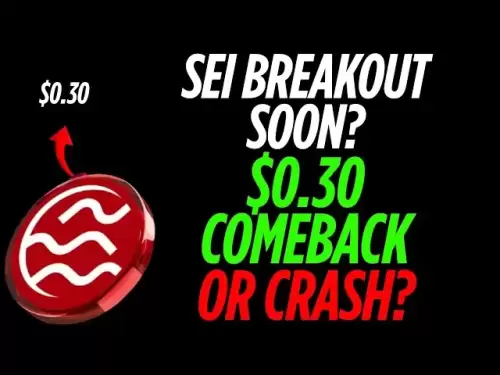-
 Bitcoin
Bitcoin $109,583.2239
0.19% -
 Ethereum
Ethereum $2,583.4612
0.48% -
 Tether USDt
Tether USDt $1.0003
-0.04% -
 XRP
XRP $2.2681
0.70% -
 BNB
BNB $659.9218
-0.52% -
 Solana
Solana $151.4961
-0.37% -
 USDC
USDC $0.9999
-0.02% -
 TRON
TRON $0.2861
1.20% -
 Dogecoin
Dogecoin $0.1718
0.04% -
 Cardano
Cardano $0.5960
-0.07% -
 Hyperliquid
Hyperliquid $40.1233
2.85% -
 Sui
Sui $2.9974
2.48% -
 Bitcoin Cash
Bitcoin Cash $497.1279
-1.76% -
 Chainlink
Chainlink $13.7275
-0.22% -
 UNUS SED LEO
UNUS SED LEO $9.0241
0.70% -
 Avalanche
Avalanche $18.5536
-0.88% -
 Stellar
Stellar $0.2421
1.39% -
 Toncoin
Toncoin $2.8593
-0.51% -
 Shiba Inu
Shiba Inu $0.0...01187
-0.07% -
 Litecoin
Litecoin $90.0023
2.90% -
 Hedera
Hedera $0.1590
2.79% -
 Monero
Monero $322.1495
0.00% -
 Polkadot
Polkadot $3.5453
-1.00% -
 Dai
Dai $1.0000
-0.01% -
 Bitget Token
Bitget Token $4.5733
-1.06% -
 Ethena USDe
Ethena USDe $1.0002
-0.01% -
 Uniswap
Uniswap $7.6345
3.03% -
 Aave
Aave $279.2583
0.47% -
 Pepe
Pepe $0.0...01003
-1.52% -
 Pi
Pi $0.4941
-0.32%
Conditions for opening Bitcoin contract
Choosing a reputable Bitcoin contract brokerage is crucial for protecting oneself from fraud and ensuring safe operations before beginning the trading process.
Nov 18, 2024 at 08:12 pm

Conditions for Opening Bitcoin Contract
1. Select a Reputable Brokerage
The first step is to choose a reputable brokerage that offers Bitcoin contracts. There are many different brokerages out there, so it is essential to do your research and find one that is regulated, has a good reputation, and offers the features and services you need.
Some of the factors you should consider when choosing a brokerage include:
- Regulation: Make sure the brokerage is regulated by a reputable financial authority. This will help to protect you from fraud and ensure that the brokerage is operating in a safe and sound manner.
- Reputation: Read online reviews of the brokerage to see what other traders have to say about their experience. This can give you a good idea of the brokerage's customer service, reliability, and overall reputation.
- Features and services: Consider the features and services that the brokerage offers. Some brokerages offer a wider range of features and services than others, so it is vital to find one that offers the features and services you need.
2. Fund Your Account
Once you have selected a brokerage, you will need to fund your account. This can be done through a variety of methods, such as bank wire, credit card, or debit card.
The minimum deposit amount will vary depending on the brokerage. However, most brokerages require a minimum deposit of $100 or more.
3. Open a Trading Account
Once you have funded your account, you will need to open a trading account. This can be done by completing an online application.
The application will ask for basic information, such as your name, address, and contact information. You will also need to provide proof of identity, such as a driver's license or passport.
4. Choose a Contract Type
There are two main types of Bitcoin contracts: futures and options.
- Futures are contracts that obligate the buyer to buy a certain amount of Bitcoin at a set price on a future date.
- Options give the buyer the right, but not the obligation, to buy or sell a certain amount of Bitcoin at a set price on a future date.
The type of contract you choose will depend on your trading goals. If you are looking to speculate on the price of Bitcoin, futures contracts may be a better option. If you are looking to hedge your exposure to Bitcoin, options contracts may be a better option.
5. Set Your Order Parameters
Once you have chosen a contract type, you will need to set your order parameters. This includes specifying the number of contracts you want to buy or sell, the price you are willing to pay or receive, and the expiration date of the contract.
You can also choose to set stop-loss and take-profit orders. These orders will automatically close your position if the price of Bitcoin reaches a certain level.
6. Place Your Order
Once you have set your order parameters, you can place your order. This can be done through the brokerage's trading platform.
The trading platform will show you the current price of Bitcoin and the bid and ask prices. You can then enter the number of contracts you want to buy or sell and the price you are willing to pay or receive.
7. Monitor Your Position
Once you have placed your order, you should monitor your position regularly. This will help you to ensure that your position is performing as expected.
You can monitor your position through the brokerage's trading platform. The trading platform will show you the current price of Bitcoin, the value of your position, and your profit or loss.
8. Close Your Position
When you are ready to close your position, you can do so through the brokerage's trading platform. This will involve selling your contracts if you bought them or buying them back if you sold them.
You can also close your position by allowing it to expire. However, this is not recommended, as you may lose money if the price of Bitcoin moves against you.
Disclaimer:info@kdj.com
The information provided is not trading advice. kdj.com does not assume any responsibility for any investments made based on the information provided in this article. Cryptocurrencies are highly volatile and it is highly recommended that you invest with caution after thorough research!
If you believe that the content used on this website infringes your copyright, please contact us immediately (info@kdj.com) and we will delete it promptly.
- BONK Price Prediction: Meme Coin Mania and What's Next?
- 2025-07-04 12:30:13
- NYAG, Stablecoins, and FDIC Protections: Navigating the Regulatory Maze
- 2025-07-04 13:10:15
- Level Up Your DeFi Game: Phantom Wallet and the Ultimate DeFi Experience
- 2025-07-04 13:10:15
- Bitcoin Surge: Breaking Down the $109,000 Barrier and the Road to $165,000?
- 2025-07-04 12:30:13
- Solana ETF Inflows & Snorter Token: A New Era for Meme Coin Trading?
- 2025-07-04 12:50:12
- Ripple, Stablecoin, and First Bank: Decoding the Latest Moves in Crypto
- 2025-07-04 12:50:12
Related knowledge

How to identify the contract value range in combination with the market profile?
Jul 02,2025 at 10:56pm
Understanding the Market ProfileTo effectively identify the contract value range in combination with the market profile, it's essential to first understand what each concept entails. The market profile is a framework that helps traders visualize how price and time interact across a given period, typically a trading day or session. It provides insights i...

How to use the price slope to filter the false breakthrough signal of the contract?
Jun 20,2025 at 06:56pm
Understanding the Concept of Price Slope in Contract TradingIn contract trading, especially within cryptocurrency derivatives markets, price slope refers to the rate at which the price changes over a specific time period. It helps traders assess the strength and sustainability of a trend. A steep slope may indicate strong momentum, while a shallow slope...

How to determine the expected volatility of the contract through the volatility cone?
Jun 19,2025 at 12:28pm
Understanding the Basics of Volatility in Cryptocurrency ContractsIn the realm of cryptocurrency trading, volatility is a key metric that traders use to assess potential risk and reward. When dealing with futures contracts, understanding how volatile an asset might become over time is crucial for position sizing, risk management, and strategy developmen...

How to formulate a contract intraday trading plan in combination with the pivot point system?
Jun 21,2025 at 03:42pm
Understanding the Basics of Pivot Points in Cryptocurrency TradingPivot points are technical analysis tools used by traders to identify potential support and resistance levels. These levels are calculated using the previous day's high, low, and closing prices. In the context of cryptocurrency trading, where markets operate 24/7, pivot points help trader...

How to adjust the contract position ratio through the price fluctuation entropy?
Jun 22,2025 at 11:42am
Understanding Price Fluctuation Entropy in Cryptocurrency ContractsIn the world of cryptocurrency futures trading, price fluctuation entropy is a relatively new concept used to measure market volatility and uncertainty. It derives from information theory, where entropy refers to the degree of randomness or unpredictability in a system. In crypto contrac...

How to use the volume swing indicator to predict the contract volume-price divergence?
Jun 18,2025 at 11:42pm
Understanding the Volume Swing IndicatorThe volume swing indicator is a technical analysis tool used primarily in cryptocurrency trading to evaluate changes in volume over time. Unlike price-based indicators, this metric focuses solely on trading volume, which can provide early signals about potential market reversals or continuations. The key idea behi...

How to identify the contract value range in combination with the market profile?
Jul 02,2025 at 10:56pm
Understanding the Market ProfileTo effectively identify the contract value range in combination with the market profile, it's essential to first understand what each concept entails. The market profile is a framework that helps traders visualize how price and time interact across a given period, typically a trading day or session. It provides insights i...

How to use the price slope to filter the false breakthrough signal of the contract?
Jun 20,2025 at 06:56pm
Understanding the Concept of Price Slope in Contract TradingIn contract trading, especially within cryptocurrency derivatives markets, price slope refers to the rate at which the price changes over a specific time period. It helps traders assess the strength and sustainability of a trend. A steep slope may indicate strong momentum, while a shallow slope...

How to determine the expected volatility of the contract through the volatility cone?
Jun 19,2025 at 12:28pm
Understanding the Basics of Volatility in Cryptocurrency ContractsIn the realm of cryptocurrency trading, volatility is a key metric that traders use to assess potential risk and reward. When dealing with futures contracts, understanding how volatile an asset might become over time is crucial for position sizing, risk management, and strategy developmen...

How to formulate a contract intraday trading plan in combination with the pivot point system?
Jun 21,2025 at 03:42pm
Understanding the Basics of Pivot Points in Cryptocurrency TradingPivot points are technical analysis tools used by traders to identify potential support and resistance levels. These levels are calculated using the previous day's high, low, and closing prices. In the context of cryptocurrency trading, where markets operate 24/7, pivot points help trader...

How to adjust the contract position ratio through the price fluctuation entropy?
Jun 22,2025 at 11:42am
Understanding Price Fluctuation Entropy in Cryptocurrency ContractsIn the world of cryptocurrency futures trading, price fluctuation entropy is a relatively new concept used to measure market volatility and uncertainty. It derives from information theory, where entropy refers to the degree of randomness or unpredictability in a system. In crypto contrac...

How to use the volume swing indicator to predict the contract volume-price divergence?
Jun 18,2025 at 11:42pm
Understanding the Volume Swing IndicatorThe volume swing indicator is a technical analysis tool used primarily in cryptocurrency trading to evaluate changes in volume over time. Unlike price-based indicators, this metric focuses solely on trading volume, which can provide early signals about potential market reversals or continuations. The key idea behi...
See all articles

























































































